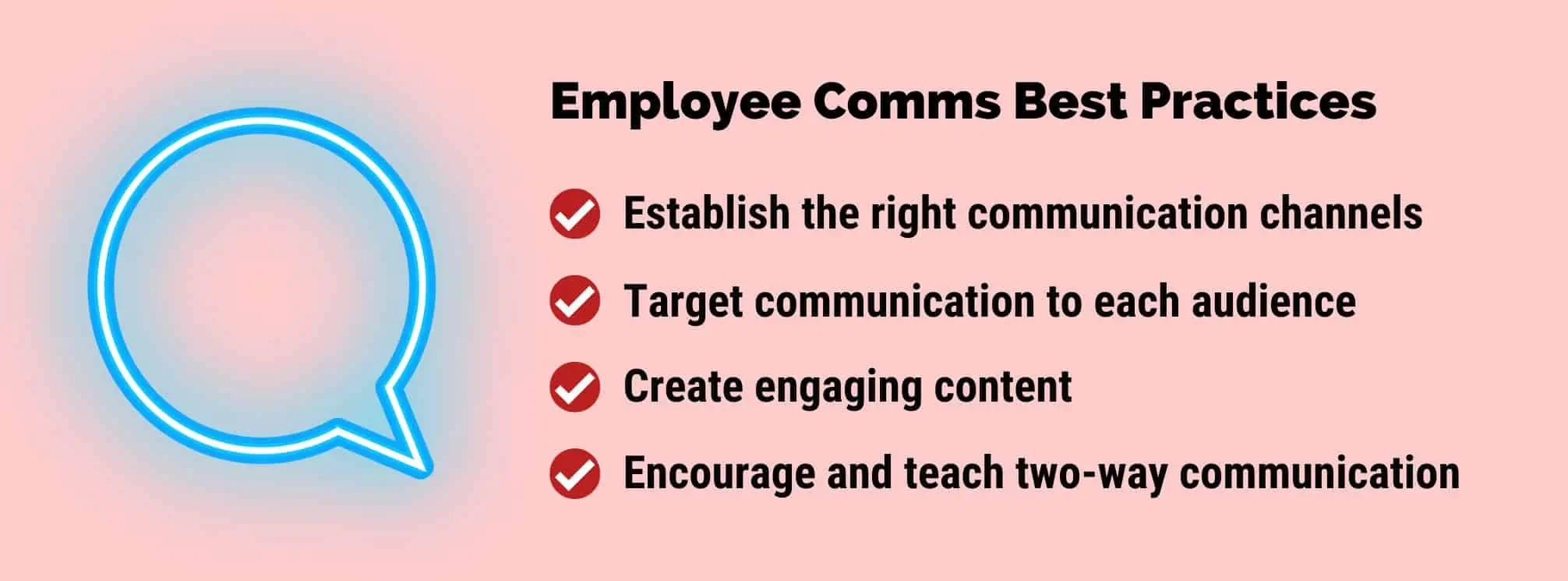Employee Communication Challenges: Trends & Solutions
Communication is essential for a company’s success. It’s been found that poor communication costs companies billions of dollars. So, understanding what the main employee communication challenges are and how to overcome them is key.
Best Practices for Effective Employee Communication
Effective employee communication is crucial for fostering engagement, alignment, and productivity within your company.
By implementing the following best practices, you can overcome communication challenges and create a thriving internal communication environment:
- Establish clear communication channels.
- Evaluate the communication channels currently in use and determine if they align with the needs and preferences of your employees. Try this audit guide template to get started!
- Use a combination of channels such as email, instant messaging, internal social platforms, and digital signage to reach different employee groups effectively.
- Ensure that communication channels are easily accessible, user-friendly, and support two-way communication.
- Tailor communication to your different employee audiences.
- Recognize that different employee groups have unique needs and preferences when it comes to communication.
- Create targeted messages that address the specific concerns and interests of each employee segment.
- Use employee personas or audience profiles to better understand your audience and deliver personalized and relevant content.
- Create engaging content.
- Craft compelling and visually appealing messages to capture employees’ attention and drive engagement.
- Use a variety of content formats such as videos, infographics, and interactive presentations to convey information in an engaging manner.
- Incorporate storytelling techniques to make your messages relatable and memorable.
- Encourage two-way communication.
- Foster a culture of open dialogue and feedback by encouraging employees to share their thoughts, ideas, and concerns.
- Provide multiple channels for employees to express their opinions, such as surveys, suggestion boxes, or dedicated feedback platforms.
- Actively listen to employee feedback, acknowledge their contributions, and communicate how their input is valued and utilized.
The Top Employee Communication Challenges
There are many challenges that can impact your ability to deliver effective employee communications. In this guide, we’ll review the top 11 comms challenges that companies are facing today.
Comms Overload
One of the biggest internal comms challenges today is the volume of messages being sent. Communication overload is when there are too many messages being shared over a period of time. This leads to recipients of the messages being unable to adequately process, engage with, and respond to all the messages they receive.
Because teams and managers specifically are so inundated with messages from their companies, we add additional strain into their workday. Too much communication—or comms shared in a way that is difficult to process—hurts efficiency and leads to more employee burnout.
Lack of Communication
It might seem counterintuitive considering comms overload is a common problem, but companies also struggle with a lack of communication.
And, yes, it is possible to have both these problems. You might be overloading one audience with communication and insufficiently communicating with others.
In fact, our annual frontline worker communication survey shows that:
- Frontline managers receive more communication than those who aren’t managers.
- Not getting enough information is the top thing that frontline workers say they would change about employee comms at their company.
- The number of frontline workers who say they want more communication has risen year over year.
Not receiving enough communication has many impacts. It can make it harder for frontline workers to do their jobs at a high level. And it can make those workers feel left out and not as connected to your culture and mission, leading to more churn.
Lack of Employee Feedback
Many companies also do not have enough employee feedback driving their employee communication strategy.
Why? Because it can be difficult and time consuming to collect, analyze, and incorporate feedback. With the limited resources comms teams have (more on that later), many communicators want more employee feedback but struggle to act on it.
This is a problem because many issues within a company could likely be solved if we listened to our employees. But too often decisions are made in silos that do not account for the employee voice.
Misunderstanding Your Audience
Because many companies struggle to collect enough employee feedback and act on it, we tend to not understand our employees well enough.
But the real challenge here is that we do not take enough time to understand each employee audience. Employee personas are great tools for internal comms, but they are seriously underused.
By not taking the time to understand the unique needs, challenges, and motivations of your various employee groups, it makes it nearly impossible to truly target and personalize content. Adapting messages for the target audience is key to driving higher engagement and follow-through on communications.
Tech Overload
The digital employee experience (DEX) has become an increasingly important part of work life. The digital revolution has done some incredible things for workplace productivity and what we are able to achieve. But it has a dark side.
As companies embrace the “future of work,” we have sometimes done so without thinking about the technical debt we put ourselves in.
By investing in innumerable tools (e.g. HRIS, employee comms, productivity, etc.), we sometimes create really difficult digital experiences for our teams. Frontline workers may have too many passwords to keep track of. They might not understand or even want some of the tools they have because they have not been properly trained on how to use them. All this adds up to an overwhelming experience that actually makes work harder.
And from an employee communication perspective, it can mean that important messages get missed entirely.
[optin-monster slug=”ltc4ezli8qbqfnbrsyhx” followrules=”true”]
Employee Comms Accessibility
Accessibility of employee comms breaks down into a few parts.
- Language barriers.
- Whether our internal comms tools are accessible to those with disabilities.
- If communication and resources are accessible to employees when they need it (e.g. can they easily access their HRIS at home when enrolling in benefits?).
Because accessibility has many facets, it sometimes is not thought about enough. Even the words we choose to use can impact how our messages are understood by our audiences.
But accessibility is critically important. We have to address this employee communication challenge if we want to enable every member of our workforce to succeed. If we do not consider accessibility, we are closing the door on talent and innovative ideas.
Timeliness of Communication
Each year in our frontline worker communication survey, the timeliness of communication comes up as a challenge. We think about timeliness in a few ways.
The first is letting employees know about important changes with sufficient notice. If an employee is expected to change their behavior without enough time or training, that change is not going to go over well.
But this also comes down to how we time letting external stakeholders and employees know about important changes. At publicly traded companies this can be a real challenge. But employees don’t like feeling like the last to know about updates that directly affect them. So, it’s important to time our communications right so employees know about key changes immediately after external announcements.
Lack of Respect
This is a disheartening trend from our annual frontline worker survey. In 2021, 2% said they wanted to be treated more respectfully in an open-ended question where we asked what the biggest improvement could be to employee comms. That rose to 8% in 2022.
This employee communication challenge ties directly to the next one—manager communication—because it can be out of an internal comms teams hands how managers communicate with their teams. But we especially have to be considerate of the language we choose to use in our messages and how we treat employees as we go through mergers, layoffs, and other corporate changes.
Manager Communication
Manager communication is repeatedly at the top of the list of employee communication challenges in the State of the Sector report. And for good reason.
Unfortunately, many managers are promoted into their position for being the best at their job—but not necessarily because they have great communication skills. Even though communication is a core responsibility of a people manager, this trend prevails.
But when managers aren’t good at communicating, it causes a ripple effect. Their direct reports don’t feel informed or respected. Productivity and retention decline. Engagement and the employee experience suffers. And all of this comes back to hurt the bottom line.
Executive Communication
Communication from the executive team is another struggle. Internal comms professionals know that CEO and leadership communication is essential. Employees need inspiration. They want to hear from their leadership. And culture as well as value alignment across a company is becoming a key consideration in where people choose to work.
But executive leaders can be difficult to convince. It can be challenging to get them behind a camera or on a podcast. They might not agree with the internal comms team’s expertise about how and why a message should be shared a certain way.
They may not want to communicate about certain things at all.
And this will continue to be an important challenge as companies fight to retain talent and improve profits going forward.
Internal Comms Team Resources
Because internal comms isn’t always valued enough by the company, one of their biggest challenges is a lack of resources. Internal comms teams often do not have sufficient budget or headcount to do all the things they want to achieve.
But as we’ve discussed, the volume of updates internal comms teams are asked to communicate is only growing. This puts a lot of pressure on this team and ends up forcing them to be stuck in reaction mode, rather than being able to take the time to strategically and proactively plan.
[optin-monster slug=”xg2kbb68nhv2imxovvlw” followrules=”true”]
Solutions for Employee Communication Challenges
So, how do we solve all these employee communication challenges?
The first step is to not try to solve everything at once. Since all these challenges stem from insufficient time and resources, we have to come up with a proper solution—not just a bandaid.
- Step 1: Conduct an internal comms audit and find out what your company’s biggest challenges are. You might struggle with all the challenges we talked about, but try to find 1 – 3 challenges that would make the biggest difference if solved.
- Step 2: Get leadership buy-in so you can secure the resource you’ll need to properly fix the issue. Keep in mind, this includes showing leadership the ROI of addressing the problem. It’s not enough to say, our managers are overworked and need communication training. You have to show them the money. What would better communication training do for your bottom line? What kind of impact might it have on retention? On eNPS scores? On productivity? Even if these are estimates based on industry benchmarks and surveys, that’s what they want to see!
- Step 3: Create a plan. Most of these challenges can’t be solved overnight. It will require time and consistency to move the needle. So, include your solution into your larger internal comms strategy and editorial calendar (if applicable) to stay on track.
- Step 4: Measure as you go so you will be able to show leadership the impact of your efforts. You don’t want to secure resources to fix a problem and then have nothing to show for it. If you continue to bring the data and show that you are a strategic advisor that impacts the business at a high-level, that’s how you continue to secure resources for internal comms.
The Role of Leadership in Overcoming Employee Communication Challenges
Effective communication starts at the top, with leaders setting the tone and leading by example. Here are some key considerations for leaders to enhance employee communication:
- Set the right tone.
- Prioritize transparent and open communication as a core value within the business.
- Communicate frequently and consistently, sharing updates, successes, challenges, and the organization’s vision and strategy.
- Encourage a culture of trust and psychological safety where employees feel comfortable sharing their thoughts and ideas.
- Communicate the vision—and keep reinforcing it.
- Clearly articulate the vision, mission, and goals to ensure alignment and inspire employees.
- Use storytelling techniques to convey the purpose and significance of the organization’s work, connecting it to employees’ individual roles and contributions.
- Reinforce the vision and goals through regular communication channels, highlighting progress and celebrating achievements.
- Leadership development.
- Provide leadership training and development programs for your people managers that emphasize effective communication skills.
- Offer workshops or coaching on active listening, empathetic communication, and delivering constructive feedback.
- Encourage leaders to continuously improve their communication skills through self-reflection and seeking feedback from their teams.
- Employee involvement.
- Involve employees in decision-making processes that impact them, seeking their input and feedback.
- Create opportunities for two-way communication, such as town hall meetings, employee forums, or suggestion programs.
- Actively listen to employee concerns, address them transparently, and communicate how their feedback influences decisions.
By following these best practices, leveraging the right technology, and embodying effective communication as a leader, companies can cultivate a culture of transparent, engaging, and impactful employee communication.
[optin-monster slug=”ucyxtz2fxemh6aryl4gg” followrules=”true”]





